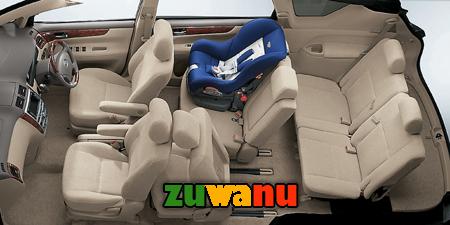Exploring the 2010 Toyota Ipsum: A Comprehensive Review
Table of Contents
Introduction:2010 Toyota Ipsum
The automotive industry has witnessed significant evolution over the years, with manufacturers constantly pushing the boundaries of design, technology, and performance. In the year 2010, Toyota introduced the Ipsum, a versatile and family-friendly vehicle that aimed to strike a balance between functionality and style. In this comprehensive review, we will delve into various aspects of the 2010 Toyota Ipsum, including its build, technology features, drive experience, design elements, dashboard layout, interior space, fuel efficiency, and a detailed examination of its pros and cons.

Build and Construction:
The 2010 Toyota Ipsum was constructed with a strong emphasis on durability and reliability, hallmarks of Toyota’s reputation in the automotive world. The vehicle was built on a robust platform, providing a sturdy foundation for its various components. The use of high-quality materials in both the exterior and interior contributed to the car’s overall longevity.
The body structure of the Ipsum was designed to prioritize passenger safety while maintaining a sleek and modern appearance. The well-crafted exterior featured smooth lines and aerodynamic contours, not only enhancing the vehicle’s aesthetics but also improving its fuel efficiency and handling.
Technology Features:
Toyota has consistently been at the forefront of automotive technology, and the 2010 Ipsum was no exception. The vehicle came equipped with a range of cutting-edge features that aimed to enhance the driving experience and ensure the safety and comfort of both the driver and passengers.
One notable technological inclusion was the advanced infotainment system. The Ipsum featured a user-friendly interface with a touchscreen display, allowing easy access to various functions such as navigation, audio controls, and connectivity options. Bluetooth integration enabled hands-free communication, contributing to safer driving practices.
Additionally, the 2010 Ipsum boasted modern safety technologies, including anti-lock braking systems (ABS), traction control, and multiple airbags strategically placed throughout the cabin. These features were designed to mitigate the impact of collisions and enhance overall vehicle safety.
Drive Experience:
The driving experience is a critical aspect of any vehicle, and the 2010 Toyota Ipsum aimed to deliver a smooth and comfortable ride. The car was powered by a range of engine options, providing flexibility for drivers with varying preferences.
The handling of the Ipsum was commendable, with responsive steering and a well-tuned suspension system that absorbed road imperfections, resulting in a comfortable and composed ride. Whether navigating city streets or cruising on the highway, the Ipsum exhibited a balanced performance that appealed to a broad audience.
The transmission options included both automatic and manual, catering to drivers who preferred different levels of control over their driving experience. The smooth transitions between gears and well-calibrated transmission contributed to the overall ease of driving the Ipsum.
Design Elements:
The exterior design of the 2010 Toyota Ipsum reflected a blend of sophistication and practicality. The sleek profile and aerodynamic features not only contributed to the vehicle’s visual appeal but also played a role in improving fuel efficiency. The well-defined character lines and carefully sculpted surfaces gave the Ipsum a modern and timeless aesthetic.
The front fascia featured Toyota’s signature grille design, complemented by stylish headlights that seamlessly integrated with the overall design. The rear of the vehicle maintained a clean and elegant look, with taillights that added a touch of sophistication.
The interior design of the Ipsum prioritized comfort and functionality. The cabin was thoughtfully laid out, with ample space for passengers and a well-organized dashboard that housed the vehicle’s controls and infotainment system. The quality of materials used in the interior contributed to a premium feel, elevating the overall driving experience.
Dashboard Layout:
The dashboard of the 2010 Toyota Ipsum was designed with a focus on user-friendliness and accessibility. The layout was intuitive, with controls positioned within easy reach of the driver. The center console housed the touchscreen display for the infotainment system, allowing for quick and convenient access to various functions.
The instrument cluster featured clear and easily readable gauges, providing essential information such as speed, fuel level, and engine status. The ergonomic design of the steering wheel incorporated controls for audio and cruise functions, further enhancing the driver’s convenience.
The use of high-quality materials on the dashboard added a touch of sophistication, creating a visually appealing and comfortable driving environment. The thoughtful placement of storage compartments and cup holders contributed to the overall practicality of the interior.
Interior Space:

One of the standout features of the 2010 Toyota Ipsum was its spacious and versatile interior. The vehicle was designed to accommodate families and passengers with diverse needs, making it an ideal choice for those seeking a practical and comfortable transportation solution.
The seating arrangement allowed for ample legroom and headroom in both the front and rear compartments. The rear seats were designed to be adjustable, providing flexibility to create additional cargo space when needed. The ability to configure the seating layout to accommodate varying passenger and cargo requirements added to the Ipsum’s appeal.
Furthermore, the inclusion of innovative storage solutions, such as under-seat compartments and cleverly designed cargo areas, showcased Toyota’s commitment to maximizing interior space without compromising on comfort.
Fuel Efficiency:
In an era where environmental concerns and fuel efficiency are paramount, the 2010 Toyota Ipsum addressed these issues with a range of fuel-efficient engines. The vehicle offered a choice of both gasoline and diesel engines, catering to different market preferences and regulations.
The engineering focus on fuel efficiency was evident in the Ipsum’s design, with aerodynamics playing a crucial role in reducing drag and improving overall fuel economy. The use of advanced engine technologies, such as variable valve timing, contributed to optimized combustion and enhanced efficiency.
The fuel efficiency of the Ipsum made it a practical choice for daily commuting and long-distance travel, providing a balance between performance and economic considerations. The availability of hybrid variants further reinforced Toyota’s commitment to environmentally friendly and sustainable driving solutions.
Pros and Cons:
As with any vehicle, the 2010 Toyota Ipsum had its strengths and areas where improvement could be considered. Here, we will explore the notable pros and cons of the Ipsum model from the year 2010.
Pros:
- Versatile Interior: The spacious and flexible interior design of the Ipsum allowed for easy customization to accommodate varying passenger and cargo needs.
- Fuel Efficiency: The range of fuel-efficient engines, including hybrid options, positioned the Ipsum as a practical and economical choice for environmentally conscious drivers.
- Advanced Safety Features: The inclusion of advanced safety technologies, such as ABS, traction control, and multiple airbags, contributed to the overall safety of the vehicle.
- Smooth Ride: The well-tuned suspension system and responsive steering provided a comfortable and composed driving experience, appealing to a broad range of drivers.
- Modern Technology Integration: The advanced infotainment system, featuring a touchscreen display and Bluetooth connectivity, added a modern touch to the driving experience and enhanced convenience.
Cons:
- Outdated Infotainment System: While the infotainment system was advanced for its time, it may be considered outdated by current standards, lacking some of the features and connectivity options found in more recent models.
- Limited Power Options: The engine options, while fuel-efficient, may not have satisfied drivers seeking higher performance or towing capabilities, as the Ipsum was primarily designed for practicality and everyday use.
- Exterior Styling Subjectivity: While many appreciated the sleek and modern exterior design, some drivers may have found the styling to be conservative, lacking the bold and eye-catching elements found in other vehicles in its class.
- Sparse Interior Luxury Features: While the interior was comfortable and well-designed, some competitors in the market offered more luxurious features and premium materials, potentially making the Ipsum less appealing to those seeking a more upscale driving experience.
Conclusion:
The 2010 Toyota Ipsum stood as a testament to Toyota’s commitment to building reliable, practical, and family-friendly vehicles. The car’s durable build, advanced technology features, comfortable interior, and fuel efficiency made it a popular choice among drivers seeking a versatile and dependable option.
While the vehicle had its strengths, such as a well-designed interior and a smooth driving experience, it also faced certain criticisms, including a somewhat conservative exterior design and an infotainment system that might not meet the expectations of those accustomed to more recent technological advancements.
Ultimately, the 2010 Toyota Ipsum catered to a specific market segment – one that prioritized functionality, efficiency, and practicality. As the automotive landscape continues to evolve, it is fascinating to reflect on how the Ipsum contributed to the trends and standards of its time, leaving behind a legacy as a reliable and versatile vehicle in Toyota’s extensive lineup.
